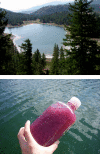An early productive ocean unfit for aerobics
- PMID: 19846788
- PMCID: PMC2775325
- DOI: 10.1073/pnas.0910345106
An early productive ocean unfit for aerobics
Conflict of interest statement
The authors declare no conflict of interest.
Figures

Comment on
-
Anoxygenic photosynthesis modulated Proterozoic oxygen and sustained Earth's middle age.Proc Natl Acad Sci U S A. 2009 Oct 6;106(40):16925-9. doi: 10.1073/pnas.0909248106. Epub 2009 Sep 28. Proc Natl Acad Sci U S A. 2009. PMID: 19805080 Free PMC article.
References
-
- Canfield DE. A new model for Proterozoic ocean chemistry. Nature. 1998;396:450–453.
-
- Shen Y, Canfield DE, Knoll AH. Evidence for low sulphate and anoxia in a mid-Proterozoic marine basin. Nature. 2003;423:632–635. - PubMed
-
- Arnold GL, Anbar AD, Barling J, Lyons TW. Molybdenum isotope evidence for widespread anoxia in mid-Proterozoic oceans. Science. 2004;304:87–90. - PubMed
-
- Poulton SW, Fralick PW, Canfield DE. The transition to a sulphidic ocean ∼1.84 billion years ago. Nature. 2004;431:173–177. - PubMed
Publication types
MeSH terms
Substances
LinkOut - more resources
Full Text Sources

